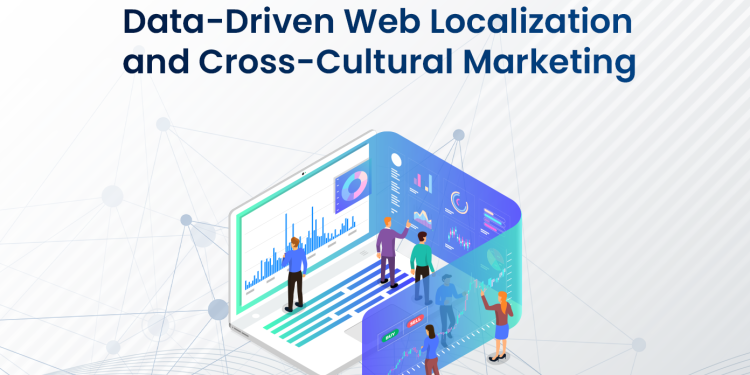It’s not surprising that Chief Marketing Officers spend about 6.5% of their budgets on analytics. Data analysis is crucial for all businesses, and especially those that want to engage with diverse customers across the globe.
Leveraging data analysis, you can supercharge the effectiveness of your web localization and cross-cultural marketing.
Keep reading to learn how to use data analytics to align your content with the preferences of different cultures and regions, thereby effortlessly crossing geographical boundaries in the pursuit of your most daring business objectives.
Overview of Web Localization in Cross-Cultural Marketing
To successfully market your products and services to diverse audiences, you need to go beyond mere translation. You need to understand and adapt your content to meet the needs, behaviors, and preferences of diverse consumer groups.
This is where web localization comes in.
Web localization entails adapting the content and functionality of a website to suit the cultural and language nuances of the target audience.
The localization process is not limited to just changing the language on the web page. It also involves adapting the visual components, including design, navigation, and even the color palette.
A project of such scope and complexity requires the use of a website localization tool that can help you effectively manage localization assets, resources, and budgets.
When done right, website localization can help you break down cultural barriers and bridge the gap between your brand and customers all over the world.
The significance of cultural sensitivity in global marketing strategies
Cultural sensitivity is essential for effective cross-cultural marketing. It involves recognizing and respecting the beliefs and values of your target audience. Without this, your marketing efforts may not resonate with potential customers.
A culturally insensitive strategy can undermine your brand’s reputation and cost money. Web localization ensures that your message is appealing and relevant to your target audience, irrespective of where they are located.
How website localization enhances cross-cultural marketing efforts
Website localization significantly benefits cross-cultural marketing in several ways. These include:
Improved user experience

Source: Pixabay
A localized website provides customers with a custom experience, thereby increasing their chance of interacting with your content, products, or services.
Enhanced engagement

Source: iStock
Website localization allows you to provide content that is in the right language and cultural context. This results in higher engagement rates and increases the time visitors spend on your website.
Higher conversion rates
Source: iStock
The ultimate goal of conversion-driven marketing is to boost sales. A website that is properly localized has a better chance of converting visitors into paying customers since it speaks to their needs and interests.
Benefits of Data-Driven Decision-Making in Localization
Data-driven decision-making in localization helps businesses engage with diverse customers. Here are the main benefits of using data analysis in the localization process:
Precision in targeting
Businesses can learn a lot about their international customers’ tastes, interests, and desires by analyzing user data and behavior. They can use this data to adapt their marketing and content strategies to appeal to specific cultural groups. This increases the likelihood of prospects viewing their content and converting into customers.
A global e-commerce firm, for example, can learn from user data analysis that customers in different regions have different shopping preferences. Businesses can respond to this by changing the layout of their website, product suggestions, and payment methods to accommodate these regional preferences. This level of precision enhances the user experience while also increasing conversion rates.
Cost-efficiency
A lack of data insights can make businesses adopt a trial-and-error process whereby they adapt content and marketing strategies without properly measuring their efficiency. As a result, resources and time may be wasted.
Data analysis, on the other hand, allows you to target your efforts where they will yield the best results. Businesses may manage their localization budgets more effectively by focusing on what works based on data-driven insights.
Improved content relevance
Delivering information that appears relevant and related to the target audience is critical for web localization success. Data analysis is required to achieve this. It helps to identify cultural differences, local preferences, and trending topics.
This helps you create content that suits your customers. Customers are more likely to connect with content and trust a business if they believe the website is relevant to their cultural identity and values.
Enhanced customer experience
Customers must have a consistent and culturally acceptable experience for them to trust your brand. Data-driven localization enhances the user experience by learning how users interact with a website or app.
By analyzing user behavior and feedback, businesses may identify pain points, optimize navigation, and shorten the customer journey. As a result, customers are happier and more satisfied, and they are more likely to suggest your brand to others.
Insights that Data Analysis Can Provide for Web Localization in Cross-Cultural Marketing
Data analysis plays an important role in web localization for cross-cultural marketing. You can make intelligent decisions that resonate with your target audience in several marketplaces by leveraging the power of data-driven insights.
Here are the different insights that you can obtain from the web localization process for cross-cultural marketing:
User behavior and engagement patterns
Understanding how people from various cultural backgrounds interact with your website is required for effective web localization. Make sure to leverage Google Analytics to gain valuable insights into user behavior and engagement trends.
You can get an idea of how users from different regions interact with your website by examining KPIs like page views, bounce rates, and session lengths.
For example, data may suggest that people from one culture spend more time on product sites, but consumers from another culture prefer to read blog content.
With this information, you can tailor your website’s navigation, layout, and content placement to each cultural group’s preferences. This not only enhances the user experience but also increases conversion rates.
Cultural preferences and trends
Data analysis can be used to discover new trends and cultural preferences that affect your target audiences.
For example, data analysis may reveal that certain colors, images, or symbols are more appealing to one culture than another. With this information, you may adapt the visual components and style of your website to reflect cultural preferences, thereby making your brand more appealing to your audience.
Furthermore, data analysis may uncover societal tendencies that influence customer behavior.
Are there any holidays, festivals, or events that influence regional purchase decisions? Discovering these patterns through data research allows you to create customized marketing campaigns and promotions that align with the cultural preferences of your audience.
Language and content optimization
Language is an important aspect of website localization. Once again, use Google Analytics to gain insights into your target markets’ preferred languages.
By examining user language preferences and content engagement metrics, you may determine whether your website should give information in multiple languages or if one language predominates in user interactions.
Furthermore, data analysis can reveal the type of content that is most appealing to specific ethnic groups.
Are interactive infographics, blog entries, or video content more likely to pique users’ interest? If your content strategy aligns with these preferences, your message will not be lost in translation, and your audience will seamlessly engage with your content.
Conversion rate optimization
Conversion rates are an important indicator of the efficiency of web localization in cross-cultural marketing. Data analysis can provide valuable information about conversion funnels and any blockages that hinder users from completing desired actions, such as making a purchase or submitting a contact form.
For instance, you can use A/B testing and conversion data analysis to identify areas where you can improve the user experience. You may need to change call-to-action buttons, optimize checkout procedures, or address security and trust challenges that are specific to certain cultural contexts.
Data-driven optimization can significantly increase conversion rates and drive revenue growth in international markets.
Conclusion
Data analysis provides invaluable insights that help businesses optimize their website localization process for cross-cultural marketing.
Whether you want to tailor language and content to align with local preferences or boost conversion rates to increase your website’s impact, data analysis gives you the precision you need to navigate the complex landscape of diverse markets.
Gracie Johnson is a Senior Content Writer at MyTechMag. She is an enthusiastic learner and loves to explore all the areas of technology.









